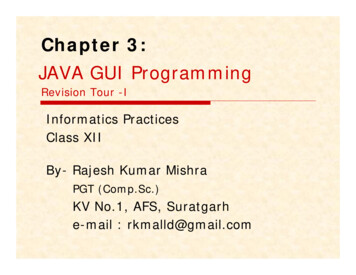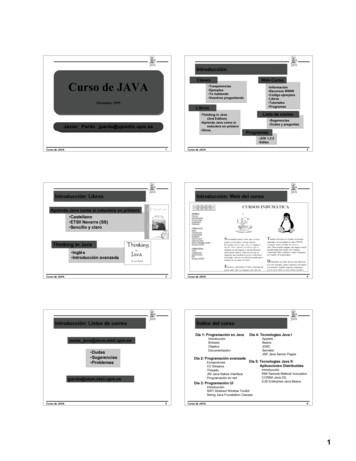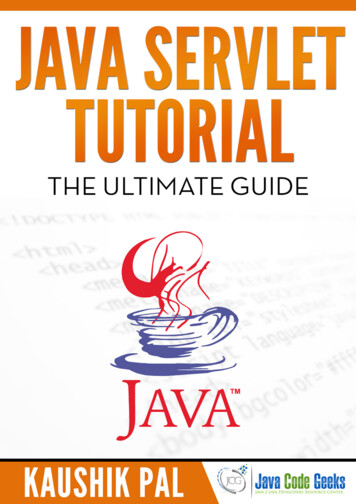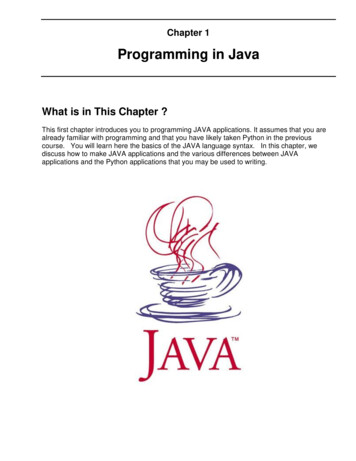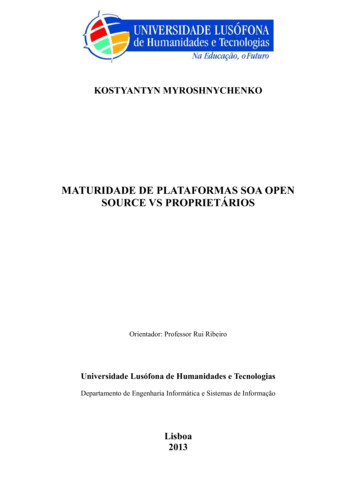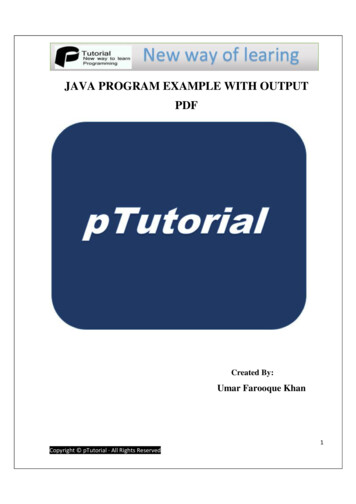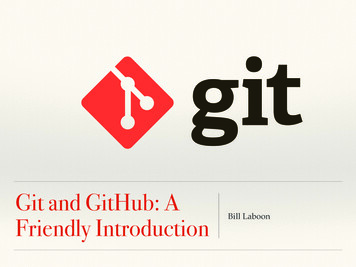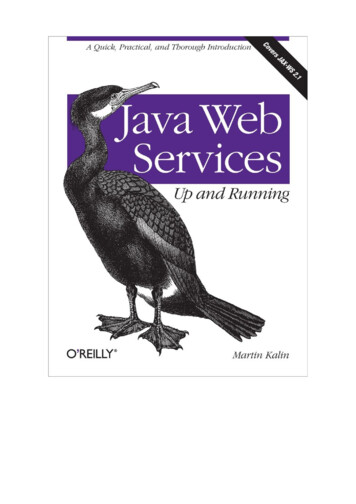
Transcription
Java Web Services: Upand RunningMartin KalinEditorJulie SteeleEditorMike LoukidesCopyright 2009 Martin KalinO’Reilly books may be purchased for educational, business, or salespromotional use. Online editions are also available for most titles(http://safari.oreilly.com). For more information, contact ourcorporate/institutional sales department: 800-998-9938 orcorporate@oreilly.com.O’Reilly and the O’Reilly logo are registered trademarks of O’ReillyMedia, Inc. Java Web Services: Up and Running, the image of a greatcormorant, and related trade dress are trademarks of O’Reilly Media,Inc.Many of the designations used by manufacturers and sellers todistinguish their products are claimed as trademarks. Where thosedesignations appear in this book, and O’Reilly Media, Inc. was awareof a trademark claim, the designations have been printed in caps orinitial caps.While every precaution has been taken in the preparation of this book,the publisher and authors assume no responsibility for errors oromissions, or for damages resulting from the use of the informationcontained herein.
O'Reilly Media
SPECIAL OFFER: Upgrade thisebook with O’ReillyClick here for more information on this offer!Please note that upgrade offers are not available from sample content.
A Note Regarding SupplementalFilesSupplemental files and examples for this book can be found athttp://examples.oreilly.com/9780596521134/. Please use astandard desktop web browser to access these files, as they maynot be accessible from all ereader devices.All code files or examples referenced in the book will beavailable online. For physical books that ship with anaccompanying disc, whenever possible, we’ve posted allCD/DVD content. Note that while we provide as much of themedia content as we are able via free download, we aresometimes limited by licensing restrictions. Please direct anyquestions or concerns to booktech@oreilly.com.
PrefaceThis is a book for programmers interested in developing Javaweb services and Java clients against web services, whatever theimplementation language. The book is a code-drivenintroduction to JAX-WS (Java API for XML-Web Services), theframework of choice for Java web services, whether SOAPbased or REST-style. My approach is to interpret JAX-WSbroadly and, therefore, to include leading-edge developmentssuch as the Jersey project for REST-style web services, officiallyknown as JAX-RS (Java API for XML-RESTful Web Services).JAX-WS is bundled into the Metro Web Services Stack, orMetro for short. Metro is part of core Java, starting withStandard Edition 6 (hereafter, core Java 6). However, the Metroreleases outpace the core Java releases. The current Metrorelease can be downloaded separately fromhttps://wsit.dev.java.net. Metro is also integrated into the Sunapplication server, GlassFish. Given these options, this book’sexamples are deployed in four different ways:Core Java onlyThis is the low-fuss approach that makes it easy to get webservices and their clients up and running. The only requiredsoftware is the Java software development kit (SDK), coreJava 6 or later. Web services can be deployed easily usingthe Endpoint, HttpServer, and HttpsServer classes. Theearly examples take this approach.Core Java with the current Metro releaseThis approach takes advantage of Metro features not yetavailable in the core Java bundle. In general, each Metrorelease makes it easier to write web services and clients. Thecurrent Metro release also indicates where JAX-WS ismoving. The Metro release also can be used with core Java 5
if core Java 6 is not an option.Standalone TomcatThis approach builds on the familiarity among Javaprogrammers with standalone web containers such asApache Tomcat, which is the reference implementation.Web services can be deployed using a web container inessentially the same way as are servlets, JavaServer Pages(JSP) scripts, and JavaServer Faces (JSF) scripts. Astandalone web container such as Tomcat is also a good wayto introduce container-managed security for web services.GlassFishThis approach allows deployed web services to interactnaturally with other enterprise components such as JavaMessage Service topics and queues, a JNDI (Java Namingand Directory Interface) provider, a backend databasesystem and the @Entity instances that mediate between anapplication and the database system, and an EJB (EnterpriseJava Bean) container. The EJB container is importantbecause a web service can be deployed as a stateless SessionEJB, which brings advantages such as container-managedthread safety. GlassFish works seamlessly with Metro,including its advanced features, and with popular IDEs(Integrated Development Environment) such as NetBeansand Eclipse.An appealing feature of JAX-WS is that the API can beseparated cleanly from deployment options. One and the sameweb service can be deployed in different ways to suit differentneeds. Core Java alone is good for learning, development, andeven lightweight deployment. A standalone web container suchas Tomcat provides additional support. A Java application serversuch as GlassFish promotes easy integration of web serviceswith other enterprise technologies.
Code-Driven ApproachMy code examples are short enough to highlight key features ofJAX-WS but also realistic enough to show off the productionlevel capabilities that come with the JAX-WS framework. Eachcode example is given in full, including all of the importstatements. My approach is to begin with a relatively sparseexample and then to add and modify features. The code samplesvary in length from a few statements to several pages of source.The code is deliberately modular. Whenever there is a choicebetween conciseness and clarity in coding, I try to opt for clarity.The examples come with instructions for compiling anddeploying the web services and for testing the service againstsample clients. This approach presents the choices that JAX-WSmakes available to the programmer but also encourages a clearand thorough analysis of the JAX-WS libraries and utilities. Mygoal is to furnish code samples that can serve as templates forcommercial applications.JAX-WS is a rich API that is explored best in a mix of overviewand examples. My aim is to explain key features about thearchitecture of web services but, above all, to illustrate eachmajor feature with code examples that perform as advertised.Architecture without code is empty; code without architecture isblind. My approach is to integrate the two throughout the book.Web services are a modern, lightweight approach to distributedsoftware systems, that is, systems such as email or the WorldWide Web that require different software components to executeon physically distinct devices. The devices can range from largeservers through personal desktop machines to handhelds ofvarious types. Distributed systems are complicated because theyare made up of networked components. There is nothing morefrustrating than a distributed systems example that does not workas claimed because the debugging is tedious. My approach isthus to provide full, working examples together with short but
precise instructions for getting the sample application up andrunning. All of the source code for examples is available fromthe book’s companion site, athttp://www.oreilly.com/catalog/9780596521127. My emailaddress is kalin@cdm.depaul.edu. Please let me know if youfind any code errors.
Chapter-by-Chapter OverviewThe book has seven chapters, the last of which is quite short.Here is a preview of each chapter:Chapter 1, Java Web Services QuickstartThis chapter begins with a working definition of webservices, including the distinction between SOAP-based andREST-style services. This chapter then focuses on the basicsof writing, deploying, and consuming SOAP-based servicesin core Java. There are web service clients written in Perl,Ruby, and Java to underscore the language neutrality of webservices. This chapter also introduces Java’s SOAP API andcovers various ways to inspect web service traffic at the wirelevel. The chapter elaborates on the relationship betweencore Java and Metro.Chapter 2, All About WSDLsThis chapter focuses on the service contract, which is aWSDL (Web Service Definition Language) document inSOAP-based services. This chapter covers the standardissues of web service style (document versus rpc) andencoding (literal versus encoded). This chapter alsofocuses on the popular but unofficial distinction between thewrapped and unwrapped variations of document style. Allof these issues are clarified through examples, including Javaclients against Amazon’s E-Commerce services. Thischapter explains how the wsimport utility can ease the taskof writing Java clients against commercial web services andhow the wsgen utility figures in the distinction betweendocument-style and rpc-style web services. The basics ofJAX-B (Java API for XML-Binding) are also covered. Thischapter, like the others, is rich in code examples.Chapter 3, SOAP Handling
This chapter introduces SOAP and logical handlers, whichgive the service-side and client-side programmer directaccess to either the entire SOAP message or just its payload.The structure of a SOAP message and the distinctionbetween SOAP 1.1 and SOAP 1.2 are covered. Themessaging architecture of a SOAP-based service isdiscussed. Various code examples illustrate how SOAPmessages can be processed in support of application logic.This chapter also explains how transport-level messages (forinstance, the typical HTTP messages that carry SOAPpayloads in SOAP-based web services) can be accessed andmanipulated in JAX-WS. This chapter concludes with asection on JAX-WS support for transporting binary data,with emphasis on MTOM (Message TransmissionOptimization Mechanism).Chapter 4, RESTful Web ServicesThis chapter opens with a technical analysis of whatconstitutes a REST-style service and moves quickly to codeexamples. The chapter surveys various approaches todelivering a Java-based RESTful service:WebServiceProvider, HttpServlet, Jersey Plain Old JavaObject (POJO), and restlet among them. The use of a WADL(Web Application Definition Language) document as aservice contract is explored through code examples. TheJAX-P (Java API for XML-Processing) packages, whichfacilitate XML processing, are also covered. This chapteroffers several examples of Java clients against real-worldREST-style services, including services hosted by Yahoo!,Amazon, and Tumblr.Chapter 5, Web Services SecurityThis chapter begins with an overview of securityrequirements for real-world web services, SOAP-based andREST-style. The overview covers central topics such as
mutual challenge and message confidentiality, users-rolessecurity, and WS-Security. Code examples clarify transportlevel security, particularly under HTTPS. Containermanaged security is introduced with examples deployed inthe standalone Tomcat web container. The security materialintroduced in this chapter is expanded in the next chapter.Chapter 6, JAX-WS in Java Application ServersThis chapter starts with a survey of what comes with a JavaApplication Server (JAS): an EJB container, a messagingsystem, a naming service, an integrated database system, andso on. This chapter has a variety of code examples: a SOAPbased service implemented as a stateless Session EJB,WebService and WebServiceProvider instances deployedthrough embedded Tomcat, a web service deployed togetherwith a traditional website application, a web serviceintegrated with JMS (Java Message Service), a web servicethat uses an @Entity to read and write from the Java DBdatabase system included in GlassFish, and a WS-Securityapplication under GlassFish.Chapter 7, Beyond the Flame WarsThis is a very short chapter that looks at the controversysurrounding SOAP-based and REST-style web services. Myaim is to endorse both approaches, either of which issuperior to what came before. This chapter traces modernweb services from DCE/RPC in the early 1990s throughCORBA and DCOM up to the Java EE and .NETframeworks. This chapter explains why either approach toweb services is better than the distributed-object architecturethat once dominated in distributed software systems.
Freedom of Choice: The Tools/IDEIssueJava programmers have a wide choice of productivity tools suchas Ant and Maven for scripting and IDEs such as Eclipse,NetBeans, and IntelliJ IDEA. Scripting tools and IDEs increaseproductivity by hiding grimy details. In a productionenvironment, such tools and IDEs are the sensible way to go. Ina learning environment, however, the goal is to understand thegrimy details so that this understanding can be brought to gooduse during the inevitable bouts of debugging and applicationmaintenance. Accordingly, my book is neutral with respect toscripting tools and IDEs. Please feel free to use whichever toolsand IDE suit your needs. My how-to segments go over codecompilation, deployment, and execution at the command line sothat details such as classpath inclusions andcompilation/execution flags are clear. Nothing in any exampledepends on a particular scripting tool or IDE.
Conventions Used in This BookThe following typographical conventions are used in this book:ItalicIndicates new terms, URLs, filenames, file extensions, andemphasis.Constant widthUsed for program listings as well as within paragraphs torefer to program elements such as variable or method names,data types, environment variables, statements, and keywords.Constant width boldUsed within program listings to highlight particularlyinteresting sections and in paragraphs to clarify acronyms.TI PThis icon signifies a tip, suggestion, or general note.
Using Code ExamplesThis book is here to help you get your job done. In general, youmay use the code in this book in your programs anddocumentation. You do not need to contact us for permissionunless you’re reproducing a significant portion of the code. Forexample, writing a program that uses several chunks of codefrom this book does not require permission. Selling ordistributing a CD-ROM of examples from O’Reilly books doesrequire permission. Answering a question by citing this bookand quoting example code does not require permission.Incorporating a significant amount of example code from thisbook into your product’s documentation does requirepermission.We appreciate, but do not require, attribution. An attributionusually includes the title, author, publisher, and ISBN. Forexample: “Java Web Services: Up and Running, by MartinKalin. Copyright 2009 Martin Kalin, 978-0-596-52112-7.”If you feel your use of code examples falls outside fair use or thepermission given above, feel free to contact us atpermissions@oreilly.com.
Safari Books OnlineNOTEWhen you see a Safari Books Online icon on the cover of yourfavorite technology book, that means the book is available onlinethrough the O’Reilly Network Safari Bookshelf.Safari offers a solution that’s better than e-books. It’s a virtuallibrary that lets you easily search thousands of top tech books,cut and paste code samples, download chapters, and find quickanswers when you need the most accurate, current information.Try it for free at http://safari.oreilly.com.
How to Contact UsPlease address comments and questions concerning this book tothe publisher:O’Reilly Media, Inc.1005 Gravenstein Highway NorthSebastopol, CA 95472800-998-9938 (in the United States or Canada)707-829-0515 (international or local)707-829-0104 (fax)We have a web page for this book, where we list errata,examples, and any additional information. You can access thispage at:http://www.oreilly.com/catalog/9780596521127/To comment or ask technical questions about this book, sendemail to:bookquestions@oreilly.comFor more information about our books, conferences, ResourceCenters, and the O’Reilly Network, see our website at:http://www.oreilly.com/
AcknowledgmentsChristian A. Kenyeres, Greg Ostravich, Igor Polevoy, and KenYu were kind enough to review this book and to offer insightfulsuggestions for its improvement. They made the book better thanit otherwise would have been. I thank them heartily for the timeand effort that they invested in this project. The remainingshortcomings are mine alone, of course.I’d also like to thank Mike Loukides, my first contact at O’ReillyMedia, for his role in shepherding my initial proposal throughthe process that led to its acceptance. Julie Steele, my editor, hasprovided invaluable support and the book would not be withouther help. My thanks go as well to the many behind-the-scenespeople at O’Reilly Media who worked on this project.This book is dedicated to Janet.
Chapter 1. Java Web ServicesQuickstartWhat Are Web Services?Although the term web service has various, imprecise, andevolving meanings, a glance at some features typical of webservices will be enough to get us into coding a web service and aclient, also known as a consumer or requester. As the namesuggests, a web service is a kind of webified application, that is,an application typically delivered over HTTP (Hyper TextTransport Protocol). A web service is thus a distributedapplication whose components can be deployed and executed ondistinct devices. For instance, a stock-picking web service mightconsist of several code components, each hosted on a separatebusiness-grade server, and the web service might be consumedon PCs, handhelds, and other devices.Web services can be divided roughly into two groups, SOAPbased and REST-style. The distinction is not sharp because, as acode example later illustrates, a SOAP-based service deliveredover HTTP is a special case of a REST-style service. SOAPoriginally stood for Simple Object Access Protocol but, byserendipity, now may stand for Service Oriented Architecture(SOA) Protocol. Deconstructing SOA is nontrivial but one pointis indisputable: whatever SOA may be, web services play acentral role in the SOA approach to software design anddevelopment. (This is written with tongue only partly in cheek.SOAP is officially no longer an acronym, and SOAP and SOAcan live apart from one another.) For now, SOAP is just an XML(EXtensible Markup Language) dialect in which documents aremessages. In SOAP-based web services, the SOAP is mostlyunseen infrastructure. For example, in a typical scenario, calledthe request/response message exchange pattern (MEP), the
client’s underlying SOAP library sends a SOAP message as aservice request, and the web service’s underlying SOAP librarysends another SOAP message as the corresponding serviceresponse. The client and the web service source code mayprovide few hints, if any, about the underlying SOAP (seeFigure 1-1).Figure 1-1. Architecture of a typical SOAP-based web serviceREST stands for REpresentational State Transfer. Roy Fielding,one of the main authors of the HTTP specification, coined theacronym in his Ph.D. dissertation to describe an architecturalstyle in the design of web services. SOAP has standards (underthe World Wide Web Consortium [W3C]), toolkits, andbountiful software libraries. REST has no standards, fewtoolkits, and meager software libraries. The REST style is oftenseen as an antidote to the creeping complexity of SOAP-basedweb services. This book covers SOAP-based and REST-styleweb services, starting with the SOAP-based ones.Except in test mode, the client of either a SOAP-based orREST-style service is rarely a web browser but rather anapplication without a graphical user interface. The client may bewritten in any language with the appropriate support libraries.Indeed, a major appeal of web services is language transparency:the service and its clients need not be written in the samelanguage. Language transparency is the key to web serviceinteroperability; that is, the ability of web services and requestersto interact seamlessly despite differences in programming
languages, support libraries, and platforms. To underscore thisappeal, clients against our Java web services will be written invarious languages such as C#, Perl, and Ruby, and Java clientswill consume services written in other languages, includinglanguages unknown.There is no magic in language transparency, of course. If aSOAP-based web service written in Java can have a Perl or aRuby consumer, there must be an intermediary that handles thedifferences in data types between the service and the requesterlanguages. XML technologies, which support structureddocument interchange and processing, act as the intermediary.For example, in a typical SOAP-based web service, a clienttransparently sends a SOAP document as a request to a webservice, which transparently returns another SOAP document asa response. In a REST-style service, a client might send astandard HTTP request to a web service and receive anappropriate XML document as a response.Several features distinguish web services from other distributedsoftware systems. Here are three:Open infrastructureWeb services are deployed using industry-standard, vendorindependent protocols such as HTTP and XML, which areubiquitous and well understood. Web services canpiggyback on networking, data formatting, security, andother infrastructures already in place, which lowers entrycosts and promotes interoperability among services.Language transparencyWeb services and their clients can interoperate even ifwritten in different programming languages. Languages suchas C/C , C#, Java, Perl, Python, Ruby, and others providelibraries, utilities, and even frameworks in support of webservices.
Modular designWeb services are meant to be modular in design so that newservices can be generated through the integration andlayering of existing services. Imagine, for example, aninventory-tracking service integrated with an online orderingservice to yield a service that automatically orders theappropriate products in response to inventory levels.What Good Are Web Services?This obvious question has no simple, single answer.Nonetheless, the chief benefits and promises of web services areclear. Modern software systems are written in a variety oflanguages—a variety that seems likely to increase. Thesesoftware systems will continue to be hosted on a variety ofplatforms. Institutions large and small have significantinvestment in legacy software systems whose functionality isuseful and perhaps mission critical; and few of these institutionshave the will and the resources, human or financial, to rewritetheir legacy systems.It is rare that a software system gets to run in splendid isolation.The typical software system must interoperate with others,which may reside on different hosts and be written in differentlanguages. Interoperability is not just a long-term challenge butalso a current requirement of production software.Web services address these issues directly because such servicesare, first and foremost, language- and platform-neutral. If alegacy COBOL system is exposed through a web service, thesystem is thereby interoperable with service clients written inother programming languages.Web services are inherently distributed systems thatcommunicate mostly over HTTP but can communicate overother popular transports as well. The communication payloads of
web services are structured text (that is, XML documents),which can be inspected, transformed, persisted, and otherwiseprocessed with widely and even freely available tools. Whenefficiency demands it, however, web services also can deliverbinary payloads. Finally, web services are a work in progresswith real-world distributed systems as their test bed. For all ofthese reasons, web services are an essential tool in any modernprogrammer’s toolbox.The examples that follow, in this chapter and the others, aremeant to be simple enough to isolate critical features of webservices but also realistic enough to illustrate the power andflexibility that such services bring to software development. Letthe examples begin.
A First ExampleThe first example is a SOAP-based web service in Java andclients in Perl, Ruby, and Java. The Java-based web serviceconsists of an interface and an implementation.The Service Endpoint Interface andService Implementation BeanThe first web service in Java, like almost all of the others in thisbook, can be compiled and deployed using core Java SE 6 (JavaStandard Edition 6) or greater without any additional software.All of the libraries required to compile, execute, and consumeweb services are available in core Java 6, which supports JAXWS (Java API for XML-Web Services). JAX-WS supportsSOAP-based and REST-style services. JAX-WS is commonlyshortened to JWS for Java Web Services. The current version ofJAX-WS is 2.x, which is a bit confusing because version 1.x hasa different label: JAX-RPC. JAX-WS preserves but alsosignificantly extends the capabilities of JAX-RPC.A SOAP-based web service could be implemented as a singleJava class but, following best practices, there should be aninterface that declares the methods, which are the web serviceoperations, and an implementation, which defines the methodsdeclared in the interface. The interface is called the SEI: ServiceEndpoint Interface. The implementation is called the SIB:Service Implementation Bean. The SIB can be either a POJO ora Stateless Session EJB (Enterprise Java Bean). Chapter 6,which deals with the GlassFish Application Server, shows howto implement a web service as an EJB. Until then, the SOAPbased web services will be implemented as POJOs, that is, asinstances of regular Java classes. These web services will bepublished using library classes that come with core Java 6 and, abit later, with standalone Tomcat and GlassFish.
CORE JAVA 6, JAX-WS, AND M ET ROJava SE 6 ships with JAX-WS. However, JAX-WS has a life outsideof core Java 6 and a separate development team. The bleeding edgeof JAX-WS is the Metro Web Services Stack(https://wsit.dev.java.net), which includes Project Tango to promoteinteroperability between the Java platform and WCF (WindowsCommunication Foundation), also known as Indigo. Theinteroperability initiative goes by the acronym WSIT (Web ServicesInteroperability Technologies). In any case, the current Metroversion of JAX-WS, hereafter the Metro release, is typically aheadof the JAX-WS that ships with the core Java 6 SDK. With Update 4,the JAX-WS in core Java 6 went from JAX-WS 2.0 to JAX-WS 2.1,a significant improvement.The frequent Metro releases fix bugs, add features, lighten the loadon the programmer, and in general strengthen JAX-WS. At the startmy goal is to introduce JAX-WS with as little fuss as possible; fornow, then, the JAX-WS that comes with core Java 6 is just fine.From time to time an example may involve more work than isneeded under the current Metro release; in such cases, the idea is toexplain what is really going on before introducing a Metro shortcut.The Metro home page provides an easy download. Once installed,the Metro release resides in a directory named jaxws-ri. Subsequentexamples that use the Metro release assume an environment variableMETRO HOME, whose value is the install directory for jaxws-ri. Theri, by the way, is short for reference implementation.Finally, the downloaded Metro release is a way to do JAX-WSunder core Java 5. JAX-WS requires at least core Java 5 becausesupport for annotations begins with core Java 5.Example 1-1 is the SEI for a web service that returns the currenttime as either a string or as the elapsed milliseconds from theUnix epoch, midnight January 1, 1970 GMT.Example 1-1. Service Endpoint Interface for the TimeServerpackage ch01.ts;// time server
s.soap.SOAPBinding.Style;/*** The annotation @WebService signals that thisis the* SEI (Service Endpoint Interface). @WebMethodsignals* that each method is a service operation.** The @SOAPBinding annotation impacts theunder-the-hood* construction of the service contract, theWSDL* (Web Services Definition Language) document.Style.RPC* simplifies the contract and makes deploymenteasier.*/@WebService@SOAPBinding(style Style.RPC) // more on thislaterpublic interface TimeServer {@WebMethod String getTimeAsString();@WebMethod long getTimeAsElapsed();}Example 1-2 is the SIB, which implements the SEI.Example 1-2. Service Implementation Bean for the TimeServerpackage ch01.ts;import java.util.Date;import javax.jws.WebService;/*** The @WebService property endpointInterfacelinks the* SIB (this class) to the SEI(ch01.ts.TimeServer).* Note that the method implementations are notannotated
* as @WebMethods.*/@WebService(endpointInterface "ch01.ts.TimeServer")public class TimeServerImpl implementsTimeServer {public String getTimeAsString() { return newDate().toString(); }public long getTimeAsElapsed() { return newDate().getTime(); }}The two files are compiled in the usual way from the currentworking directory, which in this case is immediately above thesubdirectory ch01. The symbol % represents the commandprompt:% javac ch01/ts/*.javaA Java Application to Publish the WebServiceOnce the SEI and SIB have been compiled, the web service isready to be published. In full production mode, a JavaApplication Server such as BEA WebLogic, GlassFish, JBoss,or WebSphere might be used; but in development and even lightproduction mode, a simple Java application can be used.Example 1-3 is the publisher application for the TimeServerservice.Example 1-3. Endpoint publisher for the TimeServerpackage ch01.ts;import javax.xml.ws.Endpoint;/*** This application publishes the web servicewhose* SIB is ch01.ts.TimeServerImpl. For now, the* service is published at network address127.0.0.1.,
* which is localhost, and at port number 9876,as this* port is likely available on any desktopmachine. The* publication path is /ts, an arbitrary name.** The Endpoint class has an overloaded publishmethod.* In this two-argument version, the firstargument is the* publication URL as a string and the second
This is a book for programmers interested in developing Java web services and Java clients against web services, whatever the implementation language. The book is a code-driven introduction to JAX-WS (Java API for XML-Web Services), the framework of choice for Java web services, whether SOAP-based or REST-style. My approach is to interpret JAX-WS


